Numerical Modeling of Titanium Alloy Ti10V2Fe3Al Milling Process
Abstract
:1. Introduction
2. Materials and Methods
2.1. Materials
2.2. Methods
2.2.1. Orthogonal Cutting
2.2.2. Milling
3. Results and Discussion
3.1. Orthogonal Cutting Process
3.2. Milling
4. Conclusions
Author Contributions
Funding
Data Availability Statement
Acknowledgments
Conflicts of Interest
References
- Mourtzis, D.; Doukas, M.; Bernidaki, D. Simulation in Manufacturing: Review and Challenges. Procedia CIRP 2014, 25, 213–229. [Google Scholar] [CrossRef] [Green Version]
- Arrazola, P.; Özel, T.; Umbrello, D.; Davies, M.; Jawahir, I. Recent advances in modelling of metal machining processes. CIRP Ann. Manuf. Technol. 2013, 62, 695–718. [Google Scholar] [CrossRef]
- Melkote, S.; Liang, S.Y.; Ozel, T.; Jawahir, I.S.; Stephenson, D.A.; Wang, B. A Review of Advances in Modeling of Conventional Machining Processes: From Merchant to the Present. ASME J. Manuf. Sci. Eng. 2022, 144, 110801. [Google Scholar] [CrossRef]
- Neugebauer, R.; Schmidt, G.; Dix, M.; Hoyer, U.K. Simulation von Span- und Gratbildung zur Qualitätserhöhung beim Bohren: Zerspanung in Grenzbereichen. In 5. Chemnitzer Produktionstechnisches Kolloquium; CPK-2008; Wissenschaftliche Scripten: Auerbach Vogtland, Germany, 2008; Volume 46, pp. 215–230. ISBN 978-3-937524-71-9. [Google Scholar]
- Isbilir, O.; Ghassemieh, E. Finite Element Analysis of Drilling of Titanium Alloy. Procedia Eng. 2011, 10, 1877–1882. [Google Scholar] [CrossRef] [Green Version]
- Tiffe, M.; Biermann, D. Modelling of Tool Engagement and FEM-Simulation of Chip Formation from Drilling Processes. Adv. Mater. Res. 2014, 1018, 183–188. [Google Scholar] [CrossRef]
- Risse, K. Einflüsse von Werkzeugdurchmesser und Schneidkantenverrundung beim Bohren mit Wendelbohrern in Stahl. Ph.D. Thesis, Rheinisch-Westfälischen Technischen Hochschule Aachen, Aachen, Germany, 2006; 137p. ISBN 978-3-8322-5252-6. [Google Scholar]
- Ma, L.; Marusich, T.D.; Usui, S.; Wadell, J.; Marusich, K.; Zamorano, L.; Elangovan, H. Validation of Finite Elemente Modeling of Drilling Processes with Solid Tooling in Metals. Adv. Mater. Res. 2011, 223, 182–190. [Google Scholar] [CrossRef]
- Özel, T.; Altan, T. Process simulation using finite element method—Prediction of cutting forces, tool stresses and temperatures in high-speed flat end milling. Int. J. Mach. Tools Manuf. 2000, 40, 713–738. [Google Scholar] [CrossRef]
- Mattes, A. Zerspansimulationslösungen für die Werkzeugkonstruktion und Prozessauslegung beim Fräsen. Ph.D. Dissertation, Fraunhofer-Institut für Produktionsanlagen und Konstruktionstechnik, Berlin, Germany, 2008; 169p. ISBN 978-3-8167-7847-9. [Google Scholar]
- Khosravi, J.; Azarhoushang, B.; Barmouz, M.; Bösinger, R.; Zahedi, A. High-speed milling of Ti6Al4V under a supercritical CO2 + MQL hybrid cooling system. J. Manuf. Processes 2022, 82, 1–14. [Google Scholar] [CrossRef]
- Thepsonthi, T.; Özel, T. 3-D finite element process simulation of micro-end milling Ti-6Al-4V titanium alloy: Experimental validations on chip flow and tool wear. J. Mater. Process. Technol. 2015, 221, 128–145. [Google Scholar] [CrossRef]
- Söhner, J. Beitrag zur Simulation zerspanungstechnologischer Vorgänge mit Hilfe der Finite-Elemente-Methode. Ph.D. Dissertation, Universität Karlsruhe, Karlsruhe, Germany, 2003; 148p. [Google Scholar] [CrossRef]
- Wu, H.B.; Zhang, S.J. 3D FEM simulation of milling process for titanium alloy Ti6Al4V. Int. J. Adv. Manuf. Technol. 2014, 71, 1319–1326. [Google Scholar] [CrossRef]
- Recht, R.F. Catastrophic Thermoplastic Shear. ASME J. Appl. Mech. 1964, 31, 189–193. [Google Scholar] [CrossRef]
- Heisel, U.; Krivoruchko, D.V.; Zaloha, W.A.; Storchak, M.; Stehle, T. Breakage models for the modeling of cutting processes. ZWF Z. Fuer Wirtsch. Fabr. 2009, 104, 330–339. [Google Scholar] [CrossRef]
- Zorev, N.N. Metal Cutting Mechanics; Pergamon Press: Frankfurt am Main, Germany, 1966; 526p, ISBN 978-0080107233. [Google Scholar]
- Heisel, U.; Krivoruchko, D.V.; Zaloha, W.A.; Storchak, M.; Stehle, T. Thermomechanical exchange effects in machining. ZWF Z. Fuer Wirtsch. Fabr. 2009, 104, 263–272. [Google Scholar] [CrossRef]
- Zhanga, Y.; Outeiro, J.C.; Mabroukic, T. On the selection of Johnson-Cook constitutive model parameters for Ti-6Al-4V using three types of numerical models of orthogonal cutting. Procedia CIRP 2015, 31, 112–117. [Google Scholar] [CrossRef]
- Sima, M.; Özel, T. Modified material constitutive models for serrated chip formation simulations and experimental validation in machining of titanium alloy Ti-6Al-4V. Int. J. Mach. Tools Manuf. 2010, 50, 943–960. [Google Scholar] [CrossRef]
- Cheng, W.; Outeiro, J.C. Modelling orthogonal cutting of Ti-6Al-4 V titanium alloy using a constitutive model considering the state of stress. Int. J. Adv. Manuf. Technol. 2022, 119, 4329–4347. [Google Scholar] [CrossRef]
- Calamaz, M.; Coupard, D.; Girot, F. A new material model for 2D numerical simulation of serrated chip formation when machining titanium alloy Ti–6Al–4V. Int. J. Mach. Tools Manuf. 2008, 48, 275–288. [Google Scholar] [CrossRef] [Green Version]
- Karpat, Y. Temperature dependent flow softening of titanium alloy Ti6Al4V: An investigation using finite element simulation of machining. J. Mater. Process. Technol. 2011, 211, 737–749. [Google Scholar] [CrossRef] [Green Version]
- Sui, X.; Zhang, S.; Guan, Y.; Chen, B. 3-D Finite Element Simulation Analysis of Milling Titanium Alloy Using Different Cutting Edge Radius. In Proceedings of the 2015 Sixth International Conference on Intelligent Systems Design and Engineering Applications (ISDEA), Guiyang, China, 18–19 August 2015. [Google Scholar] [CrossRef]
- Chen, X.; Khatri, A.; Ma, J.; Jahan, M.P. Numerical Investigation of the Slot Up Milling of Ti-6Al-4V. In Proceedings of the ASME 2018 13th International Manufacturing Science and Engineering Conference, College Station, TX, USA, 18–22 June 2018. [Google Scholar] [CrossRef]
- Daniyan, I.; Fameso, F.; Ale, F.; Bello, K.; Tlhabadira, I. Modelling, simulation and experimental validation of the milling operation of titanium alloy (Ti6Al4V). Int. J. Adv. Manuf. Technol. 2020, 109, 1853–1866. [Google Scholar] [CrossRef]
- Saleem, W.; Salah, B.; Velay, X.; Ahmad, R.; Khan, R.; Pruncu, C.I. Numerical Modeling and Analysis of Ti6Al4V Alloy Chip for Biomedical Applications. Materials 2020, 13, 5236. [Google Scholar] [CrossRef]
- Chen, G.; Ren, C.; Yang, X.; Jin, X.; Guo, T. Finite element simulation of high-speed machining of titanium alloy (Ti–6Al–4V) based on ductile failure model. Int. J. Adv. Manuf. Technol. 2011, 56, 1027–1038. [Google Scholar] [CrossRef]
- Gamboa, C.B.; Andersson, T.; Svensson, D.; Vilches, F.J.T.; Martín-Béjar, S.; Hurtado, L.S. Modeling of the fracture energy on the finite element simulation in Ti6Al4V alloy machining. Sci. Rep. 2021, 11, 18490. [Google Scholar] [CrossRef] [PubMed]
- Wang, Z.; Ze, X.; Yousuf, Y.A.; Jiang, Z.; Fu, X.; Pan, Y. Three-dimensional finite element simulation of high speed milling of titanium alloy Ti6Al4V. J. Phys. 2021, 1948, 012130. [Google Scholar] [CrossRef]
- Mugilan, T.; Alwarsamy, T. Prediction of cutting forces during end milling using 3D FEM based simulation analysis. Int. J. Veh. Struct. Syst. 2020, 12, 26–30. [Google Scholar] [CrossRef]
- Sun, P.; Zhang, Z.; Tian, Y.; Wang, Z.; Su, J.; Zhang, Y.; Wang, Z.; Hui, J.; Zhang, B.; He, L.; et al. Modeling and simulation of dynamic milling force for cast titanium alloy using flat end mills. In Proceedings of the International Conference on Mechanical Design and Simulation (MDS 2022), Wuhan, China, 18–20 March 2022; p. 1226137. [Google Scholar] [CrossRef]
- Pan, Z.; Liang, S.Y.; Garmestani, H. Finite element simulation of residual stress in machining of Ti-6Al-4V with a microstructural consideration. Proc. Inst. Mech. Eng. Part B J. Eng. Manuf. 2019, 233, 1103–1111. [Google Scholar] [CrossRef]
- Arisoy, Y.; Guo, C.; Kaftanoglu, B.; Özel, T. Investigations on microstructural changes in machining of Inconel 100 alloy using face turning experiments and 3D finite element simulations. Int. J. Mech. Sci. 2016, 107, 80–92. [Google Scholar] [CrossRef]
- Boyer, R.R.; Briggs, R.D. The Use of ß-Titanium Alloys in the Aerospace Industry. J. Mater. Eng. Perform. 2005, 14, 681–685. [Google Scholar] [CrossRef]
- Changfeng, Y.; Daoxia, W.; Liang, T.; Junxue, R.; Kaining, S.; Zhenchao, Y. Effects of cutting parameters on surface residual stress and its mechanism in high-speed milling of TB6. Proc. Inst. Mech. Eng. Part B J. Eng. Manuf. 2013, 227, 483–493. [Google Scholar] [CrossRef]
- Yao, C.; Wu, D.-X.; Jin, Q.-C.; Huang, X.-C.; Ren, J.-X.; Zhang, D.-H. Influence of high-speed milling parameter on 3D surface topography and fatigue behavior of TB6 titanium alloy. Trans. Nonferrous Met. Soc. China 2013, 23, 650–660. [Google Scholar] [CrossRef]
- Yang, H.; Chen, Z.; Like, J. Experimental study on hardness of titanium alloy Ti-1023 by milling. Adv. Mater. Res. 2013, 690, 2446–2449. [Google Scholar] [CrossRef]
- Yang, H.; Chen, Z.; Chen, M. Experimental Study on the Impact of Cutting Speed on Surface Integrity of Ti-10V-2Fe-3Al. Adv. Mater. Res. 2014, 852, 476–480. [Google Scholar] [CrossRef]
- Yang, H.; Chen, Z.; Zhou, Z. Influence of cutting speed and tool wear on the surface integrity of the titanium alloy Ti-1023 during milling. Int. J. Adv. Manuf. Technol. 2015, 78, 1113–1126. [Google Scholar] [CrossRef] [Green Version]
- Liu, D.; Wang, F.; Wang, J.M.; Xue, Y.; Xue, J. Orthogonal Experimental Study on Tool Life in Milling TB6 Titanium Alloy. IOP Conf. Ser. Mater. Sci. Eng. 2017, 265, 012018. [Google Scholar] [CrossRef]
- Rashid, R.A.R.; Sun, S.; Palanisamy, S.; Wang, G.; Dargusch, M.S. A study on laser assisted machining of Ti10V2Fe3Al alloy with varying laser power. Int. J. Adv. Manuf. Technol. 2014, 74, 219–224. [Google Scholar] [CrossRef]
- Wagner, V.; Duc, E. Study of Ti-1023 milling with toroidal tool. Int. J. Adv. Manuf. Technol. 2014, 75, 1473–1491. [Google Scholar] [CrossRef] [Green Version]
- Storchak, M.; Jiang, L.; Xu, Y.; Li, X. Finite element modeling for the cutting process of the titanium alloy Ti10V2Fe3Al. Prod. Eng. Res. Dev. 2016, 10, 509–517. [Google Scholar] [CrossRef]
- Jaiswal, A.P.; Khanna, N.; Bajpai, V. Orthogonal machining of Heat Treated Ti-10-2-3: FE and Experimental. Mater. Manuf. Processes 2020, 35, 1822–1831. [Google Scholar] [CrossRef]
- Lei, Z.; Pei, L. Cutting mechanism of straight-tooth milling process of titanium alloy TC21 based on simulation and experiment. PLoS ONE 2021, 16, e0258403. [Google Scholar] [CrossRef]
- Boyer, R.R. Design Properties of a High-Strength Titanium Alloy, Ti-10V-2Fe-3Al. J. Met. 1980, 32, 61–65. [Google Scholar] [CrossRef]
- Storchak, M.; Stehle, T.; Möhring, H.-C. Determination of thermal material properties for the numerical simulation of cutting processes. Int. J. Adv. Manuf. Technol. 2022, 118, 1941–1956. [Google Scholar] [CrossRef]
- Kushner, V.; Storchak, M. Determining mechanical characteristics of material resistance to deformation in machining. Prod. Eng. Res. Dev. 2014, 8, 679–688. [Google Scholar] [CrossRef]
- Tsekhanov, J.; Storchak, M. Development of analytical model for orthogonal cutting. Production Engineering. Res. Dev. 2015, 9, 247–255. [Google Scholar] [CrossRef]
- Johnson, G.R.; Cook, W.H. A constitutive model and data for metals subjected to large strains, high strain and high temperatures. In Proceedings of the 7th International Symposium on Ballistics, The Hague, The Netherlands, 19–21 April 1983; pp. 541–547. [Google Scholar]
- Cockroft, M.G.; Latham, D.J. Ductility and workability of metals. J. Inst. Met. 1968, 96, 33–39. [Google Scholar] [CrossRef]
- Filatov, Y.D.; Filatov, A.Y.; Syrota, O.O.; Yashchuk, V.P.; Monteil, G.; Heisel, U.; Storchak, M. The influence of tool wear particles scattering in the contact zone on the workpiece surface microprofile formation in polishing quartz. J. Superhard Mater. 2010, 32, 415–422. [Google Scholar] [CrossRef]
- Filatov, Y.D.; Sidorko, V.I.; Filatov, O.Y.; Yaschuk, V.P.; Heisel, U.; Storchak, M. Surface quality control in diamond abrasive finishing. Proc. SPIE 2009, 7389, 73892O. [Google Scholar] [CrossRef]
- Kushner, V.; Storchak, M. Modelling the Material Resistance to Cutting. Int. J. Mech. Sci. 2017, 126, 44–54. [Google Scholar] [CrossRef]
- Fluhrer, J. Deform—User Manual Deform V12.0; SFTC: Columbus, OH, USA, 2019. [Google Scholar]
- Heisel, U.; Krivoruchko, D.V.; Zaloha, W.A.; Storchak, M.; Stehle, T. Thermomechanical material models in the modeling of cutting processes. ZWF Z. Fuer Wirtsch. Fabr. 2009, 104, 482–491. [Google Scholar] [CrossRef]
- Storchak, M.; Möhring, H.-C.; Stehle, T. Improving the friction model for the simulation of cutting processes. Tribol. Int. 2022, 167, 107376. [Google Scholar] [CrossRef]
- Storchak, M.; Stehle, T.; Möhring, H.-C. Determination of the Shear Angle in the Orthogonal Cutting Process. J. Manuf. Mater. Process. 2022, 6, 132. [Google Scholar] [CrossRef]
- Storchak, M.; Drewle, K.; Menze, C.; Stehle, T.; Möhring, H.-C. Determination of the Tool–Chip Contact Length for the Cutting Processes. Materials 2022, 15, 3264. [Google Scholar] [CrossRef]
- Sun, S.; Brandt, M.; Dargusch, M.S. Characteristics of cutting forces and chip formation in machining of titanium alloys. Int. J. Mach. Tools Manuf. 2009, 49, 561–568. [Google Scholar] [CrossRef]
- Kushner, V.; Storchak, M. Determination of Material Resistance Characteristics in Cutting. Procedia CIRP 2017, 58, 293–298. [Google Scholar] [CrossRef]
- Schaal, N.; Kuster, F.; Wegener, K. Springback in metal cutting with high cutting speeds. Procedia CIRP 2015, 31, 24–28. [Google Scholar] [CrossRef] [Green Version]
- Storchak, M.; Zakiev, I.; Träris, L. Mechanical properties of subsurface layers in the machining of the titanium alloy Ti10V2Fe3Al. J. Mech. Sci. Technol. 2018, 32, 315–322. [Google Scholar] [CrossRef]
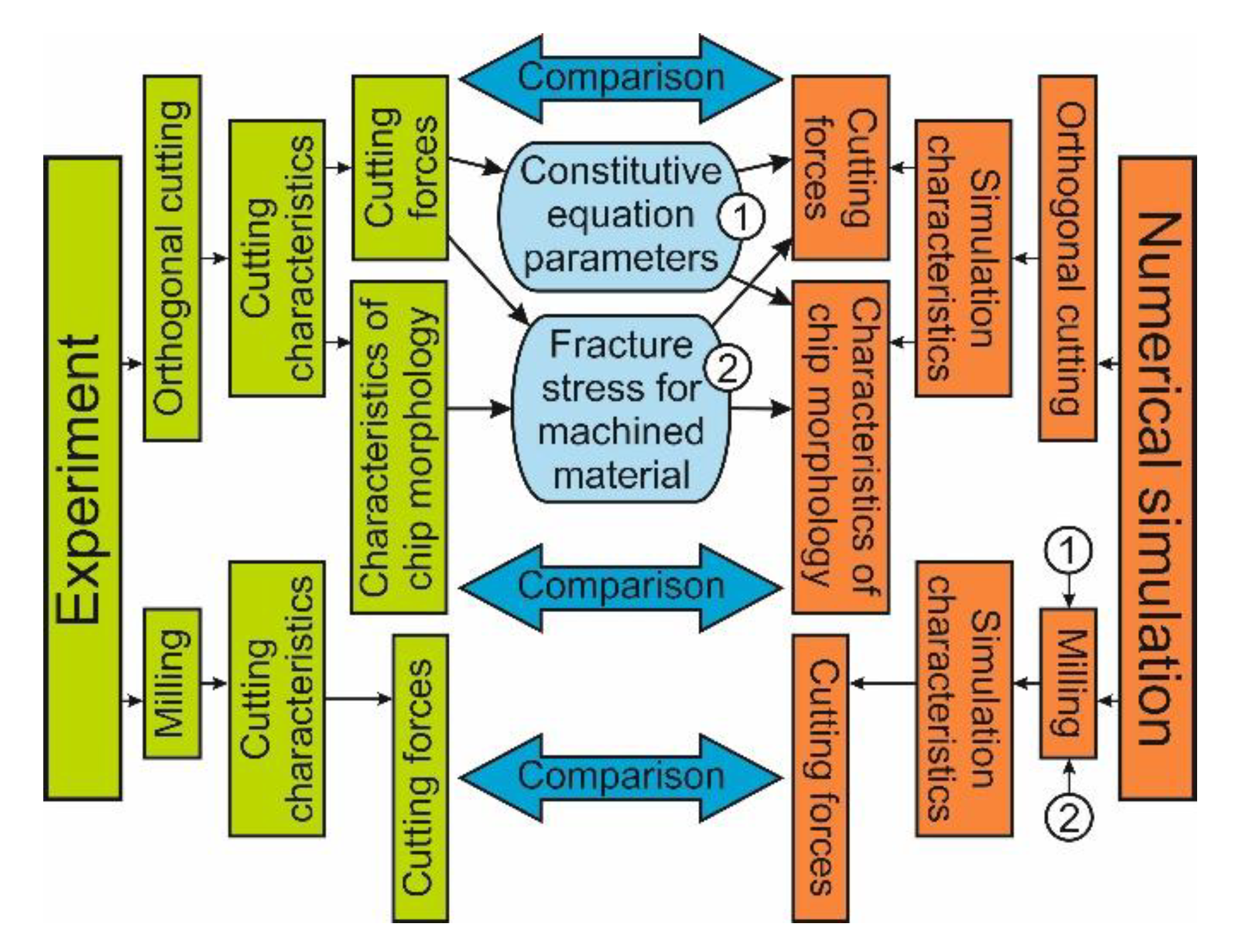
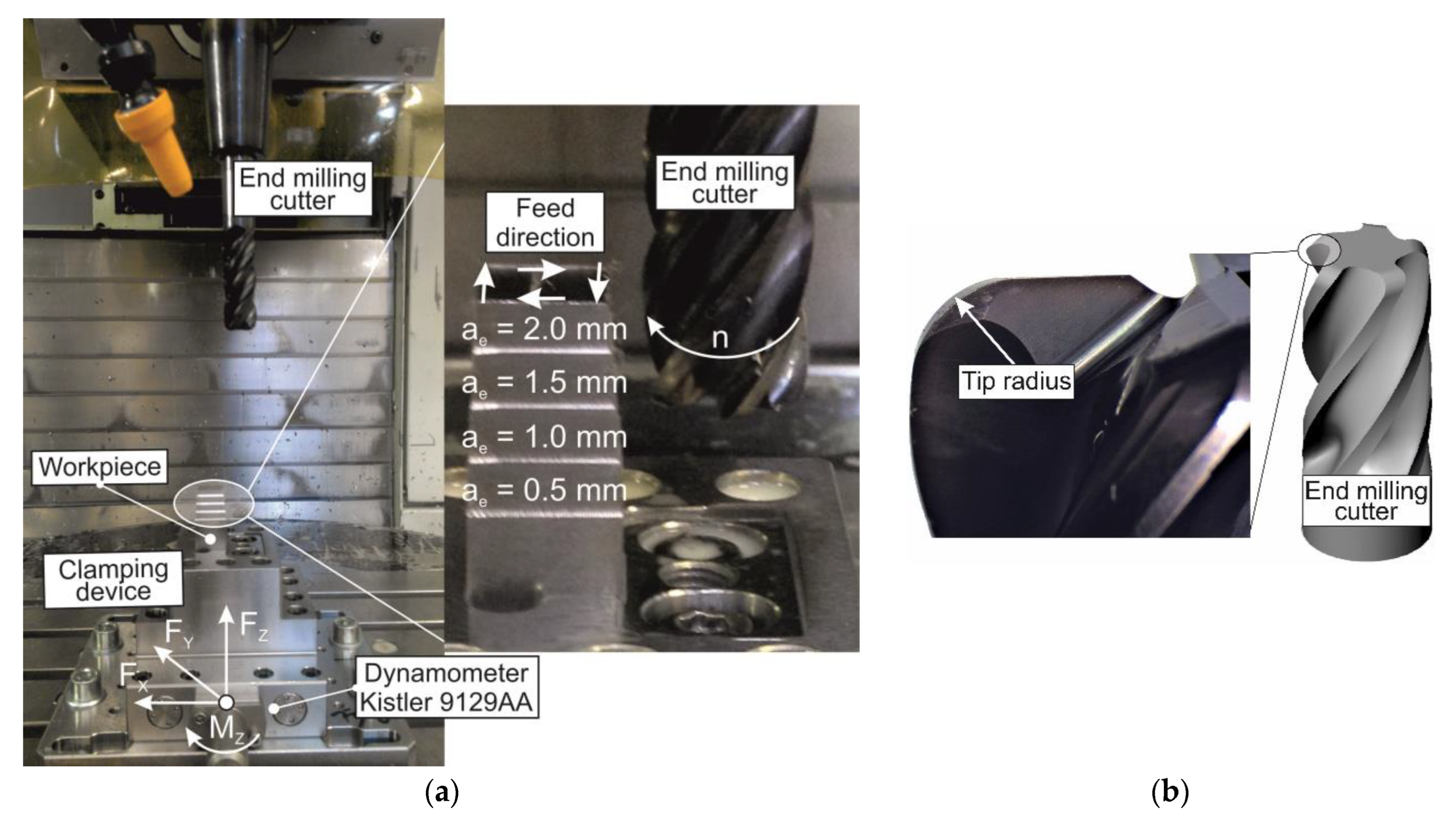

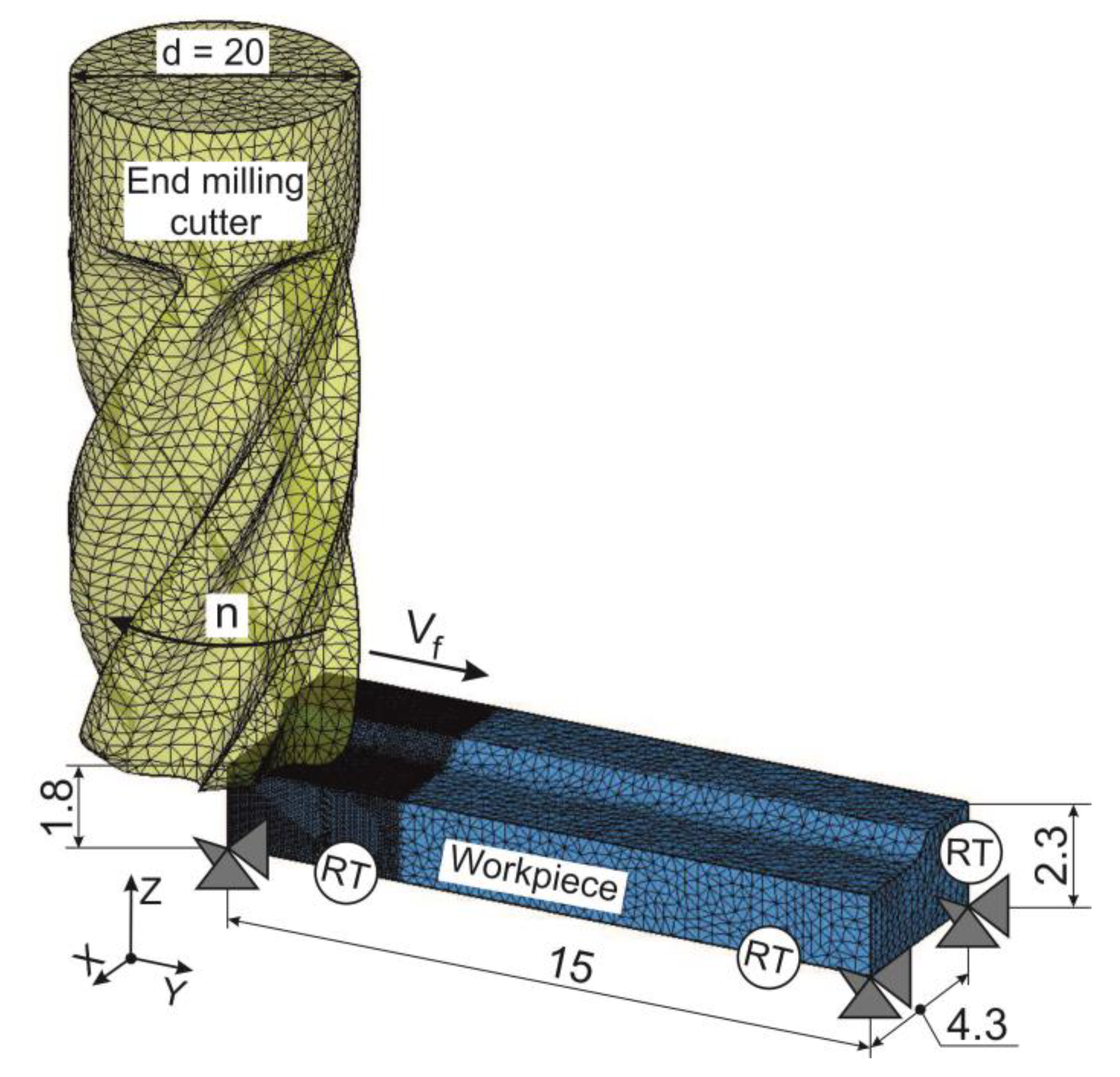
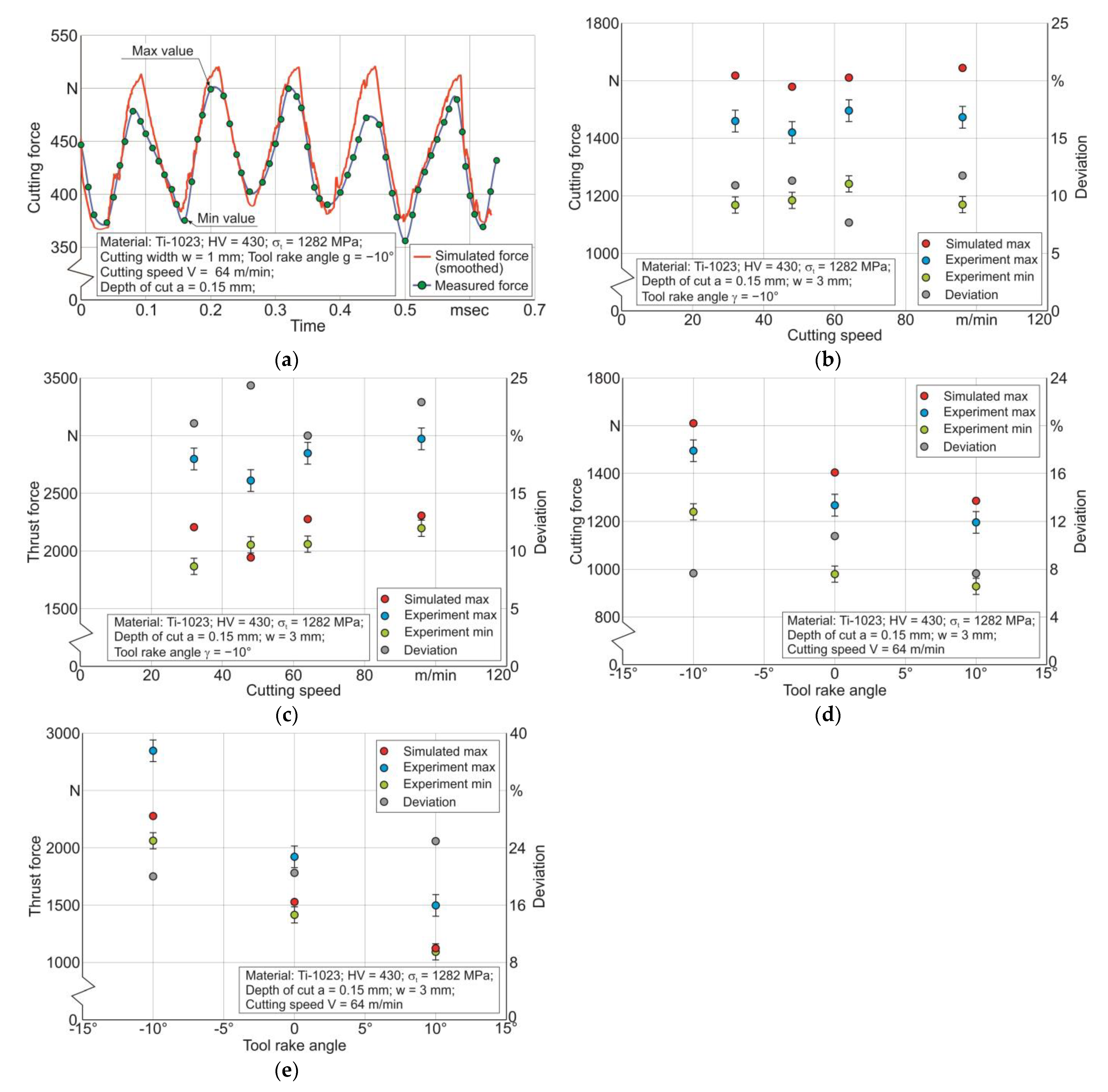
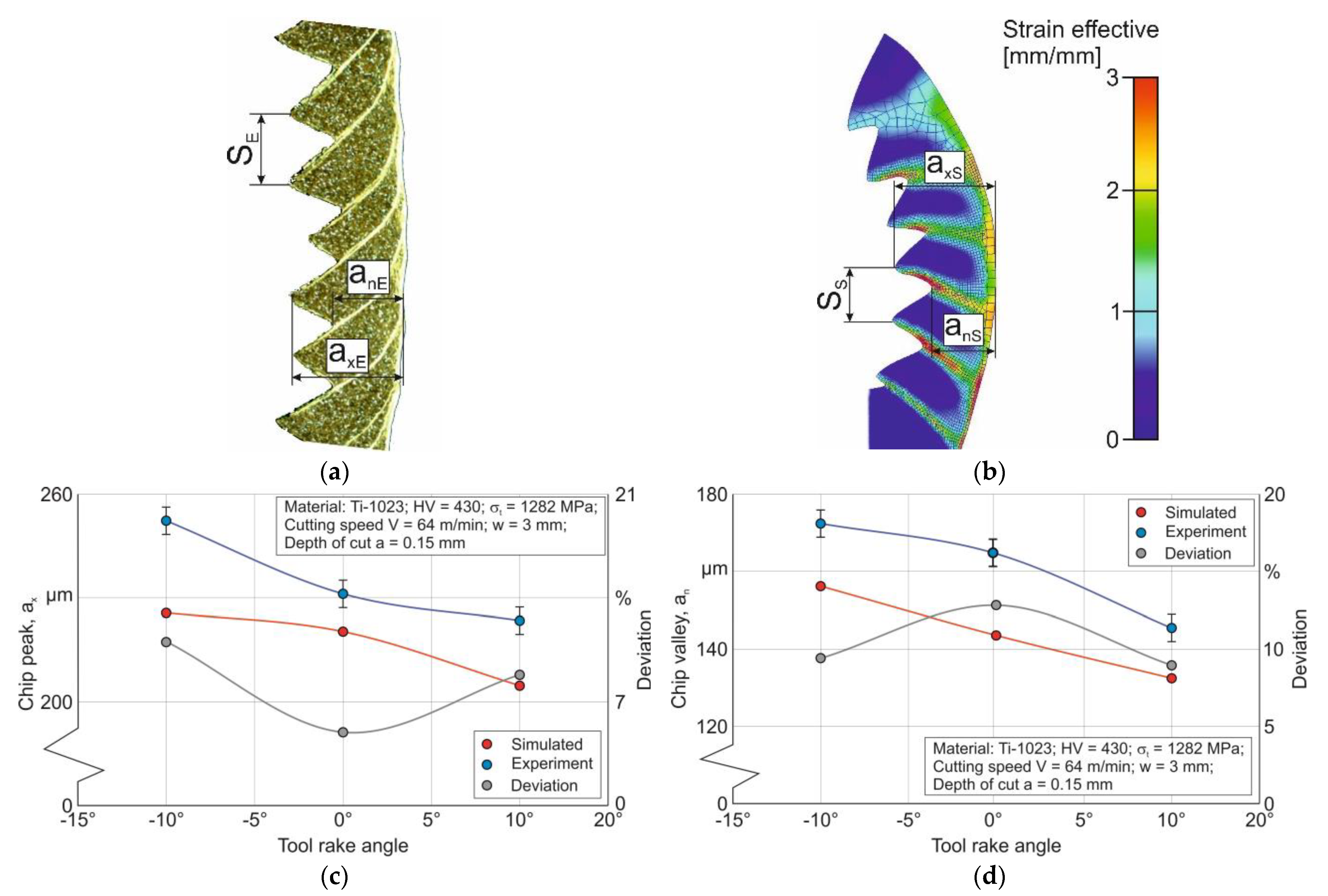
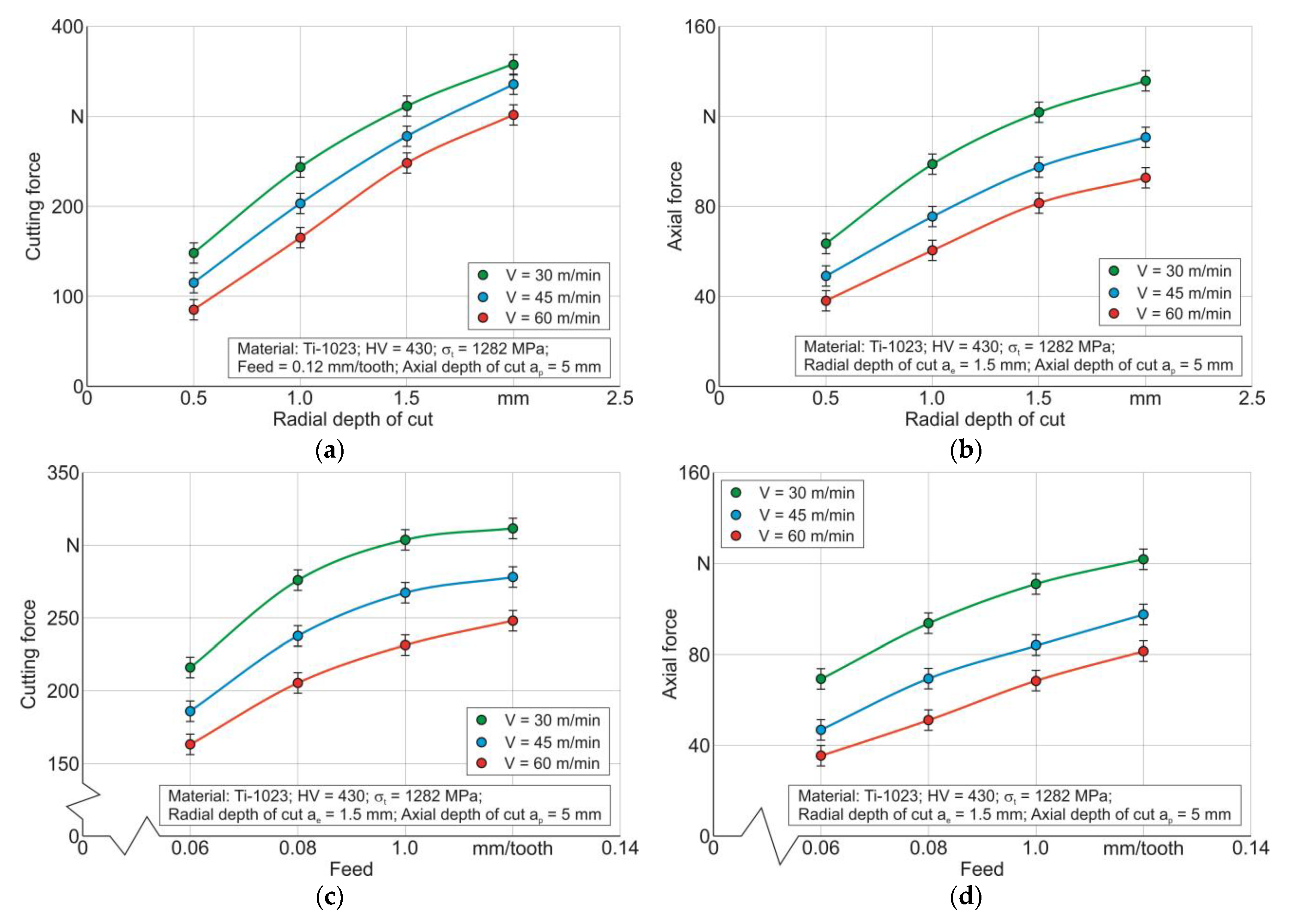
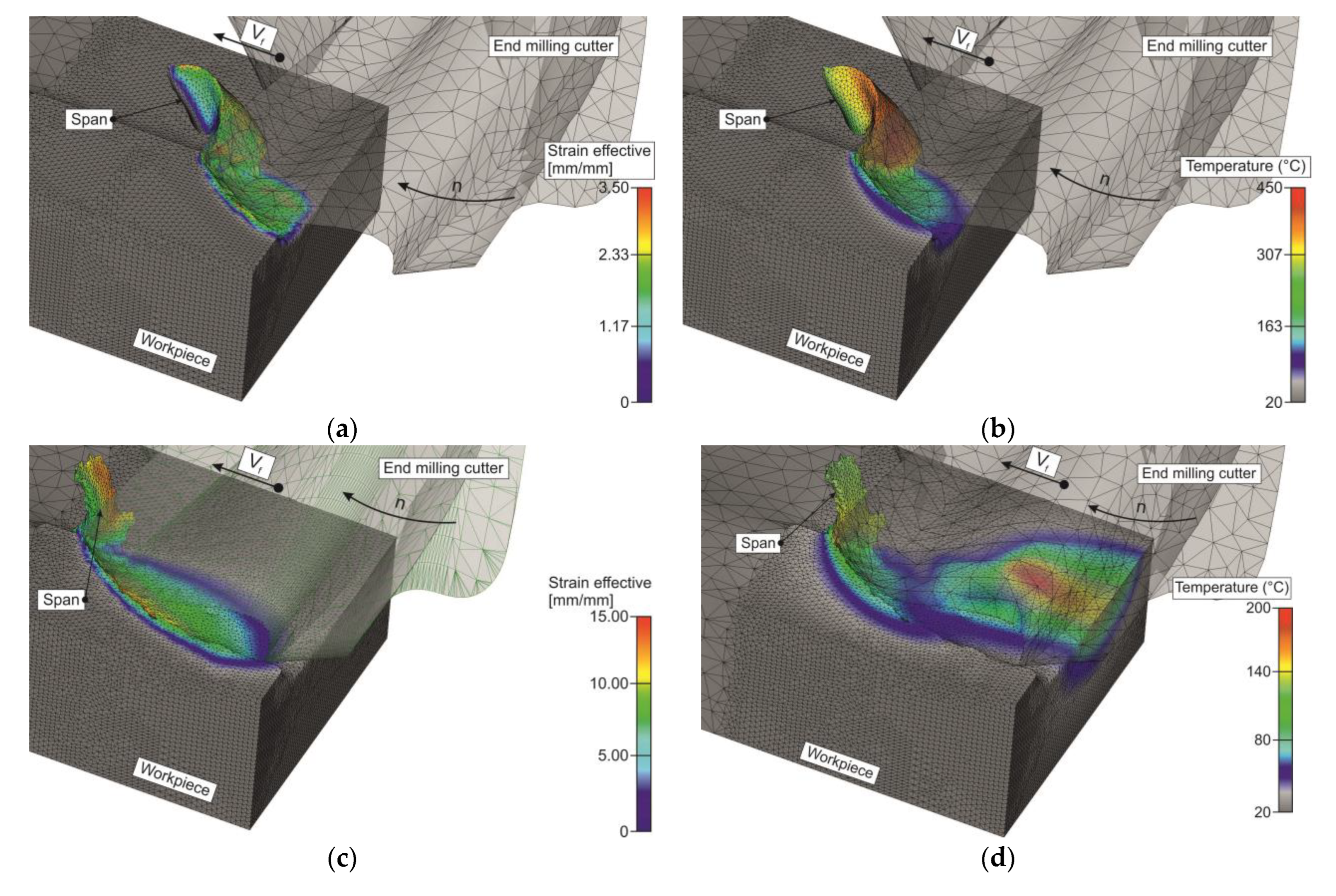
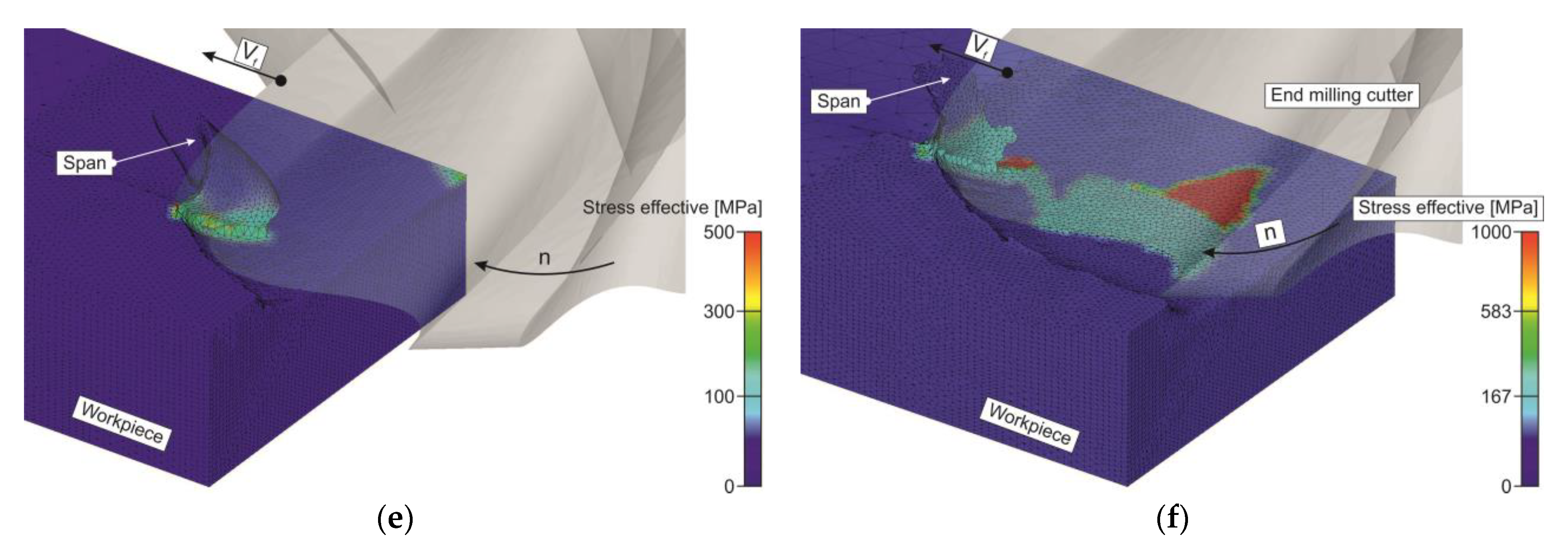
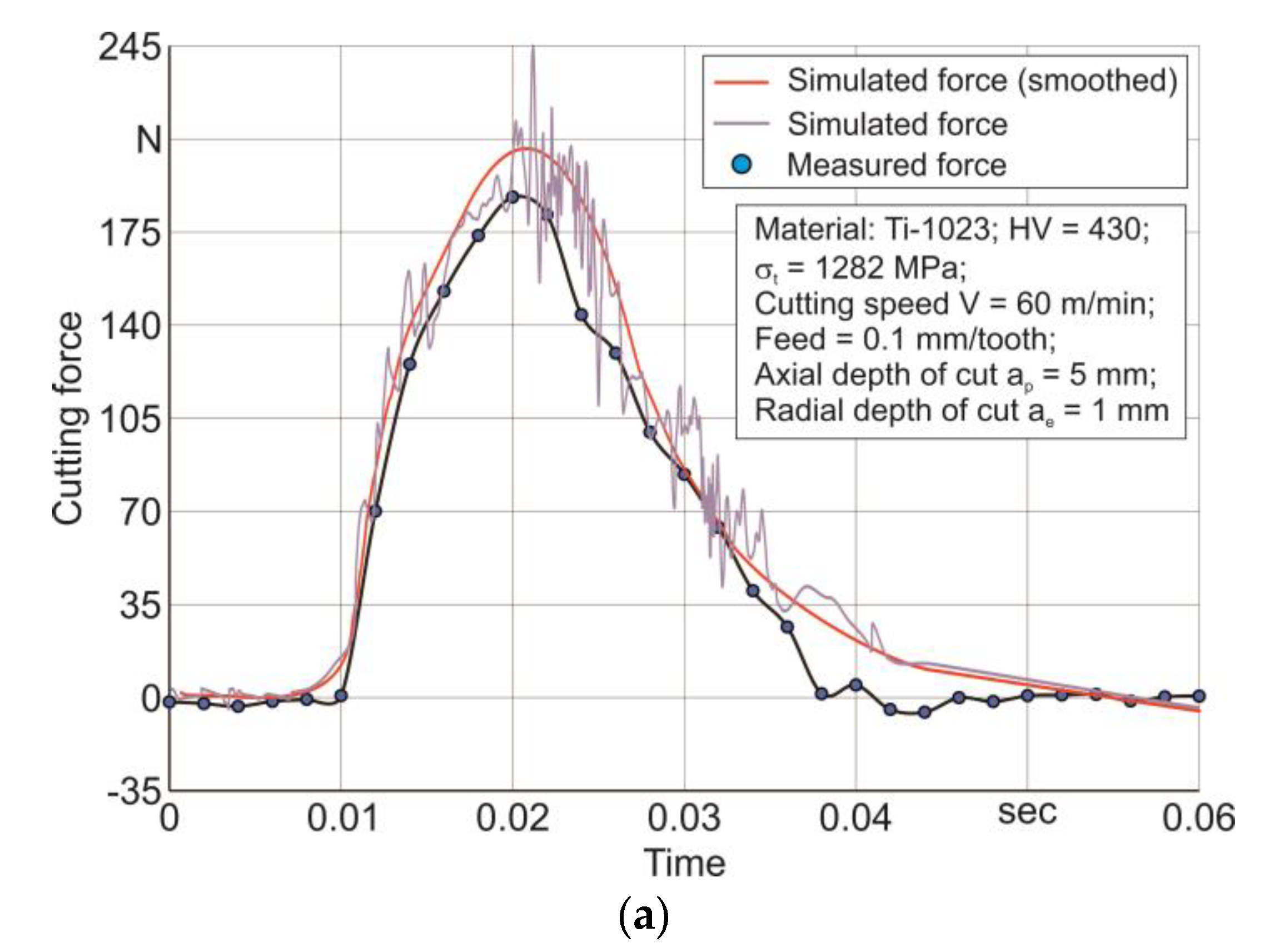
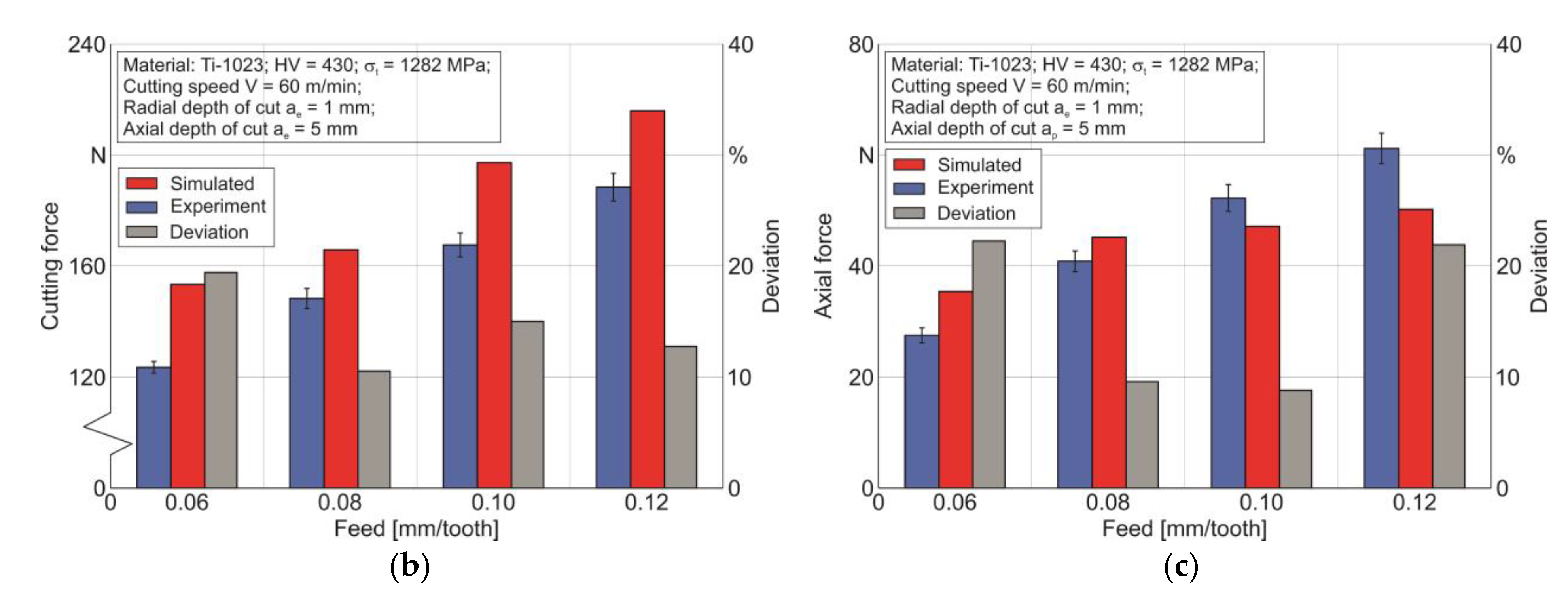
| Material | Strength (MPa) | Elastic Modulus (GPa) | Elongation (%) | Hardness HV | Poisson’s Ratio | Specific Heat (J/kg·K) | Thermal Expansion (µm/m·°C) | Thermal Conductivity (W/m·K) | |
|---|---|---|---|---|---|---|---|---|---|
| Tensile | Yield | ||||||||
| Ti-1023 | 1282 | 1220 | 110 | 4 ~ 10 | ~430 | 0.35 | 527 | 9.7 | 7 |
| Constitutive Parameters | ||||
|---|---|---|---|---|
| A (MPa) | B (MPa) | n | C | m |
| 985.7 | 634.7 | 0.2351 | 0.02812 | 0.87 |
Disclaimer/Publisher’s Note: The statements, opinions and data contained in all publications are solely those of the individual author(s) and contributor(s) and not of MDPI and/or the editor(s). MDPI and/or the editor(s) disclaim responsibility for any injury to people or property resulting from any ideas, methods, instructions or products referred to in the content. |
© 2022 by the authors. Licensee MDPI, Basel, Switzerland. This article is an open access article distributed under the terms and conditions of the Creative Commons Attribution (CC BY) license (https://creativecommons.org/licenses/by/4.0/).
Share and Cite
Storchak, M.; Stehle, T.; Möhring, H.-C. Numerical Modeling of Titanium Alloy Ti10V2Fe3Al Milling Process. J. Manuf. Mater. Process. 2023, 7, 1. https://doi.org/10.3390/jmmp7010001
Storchak M, Stehle T, Möhring H-C. Numerical Modeling of Titanium Alloy Ti10V2Fe3Al Milling Process. Journal of Manufacturing and Materials Processing. 2023; 7(1):1. https://doi.org/10.3390/jmmp7010001
Chicago/Turabian StyleStorchak, Michael, Thomas Stehle, and Hans-Christian Möhring. 2023. "Numerical Modeling of Titanium Alloy Ti10V2Fe3Al Milling Process" Journal of Manufacturing and Materials Processing 7, no. 1: 1. https://doi.org/10.3390/jmmp7010001





